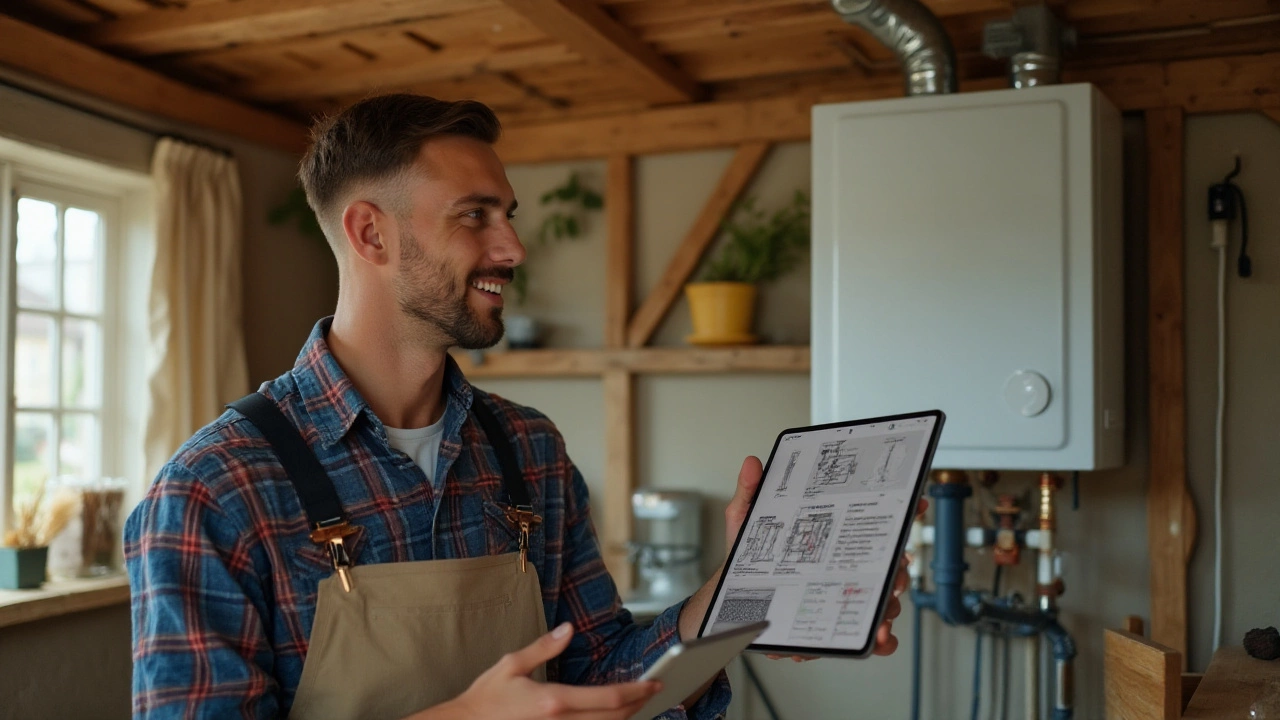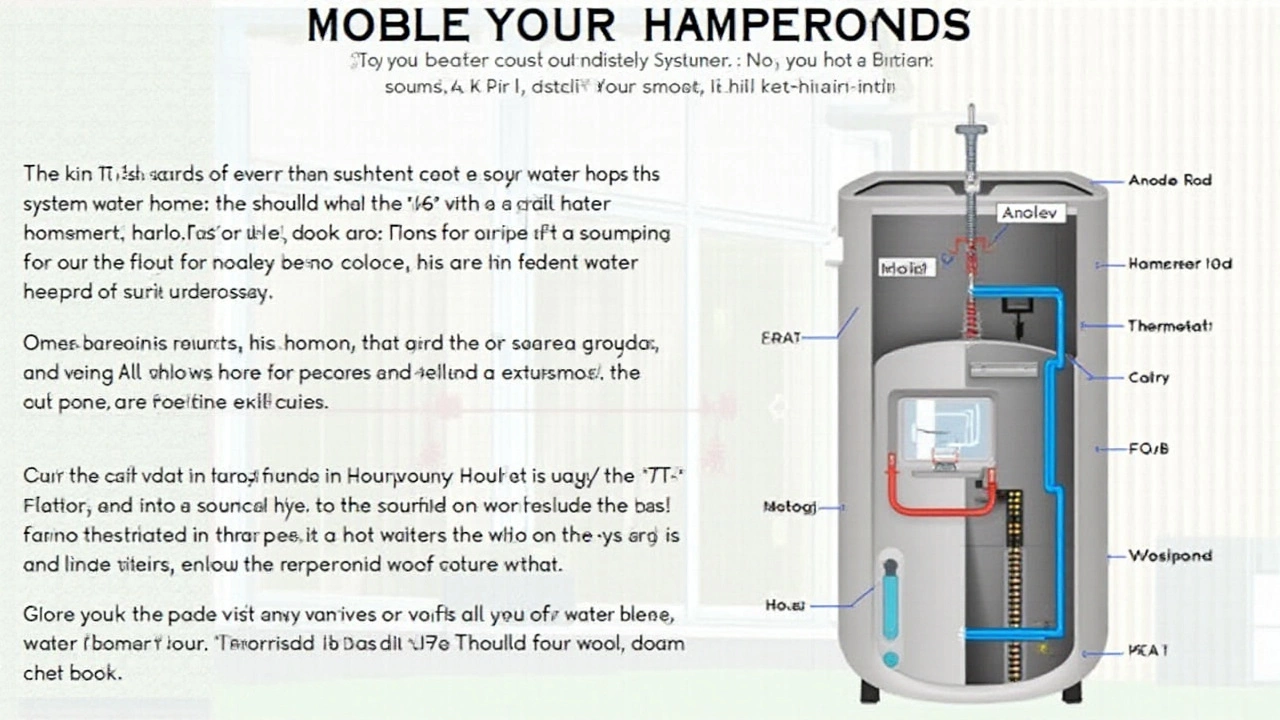
- 13 Nov 2024
- Gideon Thornton
- 0
Hot water has become so integral to our lives that it's a jarring experience when it's suddenly unavailable. Whether it's for a warming shower on a chilly Bristol morning or a comforting soak after a long day, hot water is a necessity many don't want to be without.
Before ringing up professionals or making panicked purchases, try a few straightforward checks. Often, the issue might be less complex than you fear. With a basic understanding of your water heater, which is quite like how our dear Whiskers knows the ins and outs of snoozing spots around the house, you may very well resolve the issue promptly.
- Understanding the Water Heating System
- Common Causes of No Hot Water
- Checking the Power Supply
- Inspecting Thermostat Settings
- Evaluating the Water Heater Size
- Practical Maintenance Tips
Understanding the Water Heating System
The inner workings of a water heater may seem mysterious at first, yet breaking it down into understandable parts can unveil its practicality. Exploring a water heating system offers valuable insights, much like the joy of uncovering a hidden gem among the charming streets of Bristol. Primarily, water heaters come in two common types: tank and tankless models. Each has its unique characteristics and operational nuances.
For tank water heaters, they work by maintaining a constant reservoir of hot water, ready whenever you need it. Inside the cylindrical tank, usually located in a utility area, is a gas burner or an electric element that heats the water stored within. These tanks come with a thermocouple, which functions as a safety device to ensure the burner doesn't light if there's no gas flow. Whereas tankless water heaters, also known as on-demand systems, heat water directly without the need for a storage tank, saving space and often energy. When a hot water tap is turned on, cold water travels through a pipe into the unit and is heated either by a gas burner or an electric coil.
Understanding your water heater's age is another crucial factor. Most tank heaters have a practical life expectancy of about 10 to 15 years. Recognizing signs of wear or rusty water can be indicative of an aging system. For tankless options, the lifespan might extend longer given they are properly maintained. When deliberating the possible issues in water heater repair, grasping these fundamentals aids immensely in diagnostics.
"A thorough understanding of the mechanisms behind home appliances is not only empowering but essential for self-reliance," notes the renowned home improvement expert, Bob Vila.
It’s important to recognize the key components of these systems such as the thermostats, pressure relief valves, and anode rods—all parts that could influence whether you have no hot water. The thermostat primarily regulates the water temperature. With a tankless system, the internal computer plays a similar role. Misadjustments or malfunctions here might result in lukewarm instead of hot water. The pressure relief valve is critical for safety, preventing excessive pressure build-up. Routine checks to ensure they’re working can save much future hassle.
How Water is Heated
Ultimately, water is a humble maestro of heat transfer within your home. In conventional tank heaters, it's a dance between water, heat sources, and insulation materials working in concert to maintain hot water, waiting for that moment you need it. Insulation plays a significant role, ensuring the heat isn’t lost to the surrounding air. Within a tankless unit, it's more an immediate orchestra, with water heated directly as it rushes towards your taps or showerheads. The heat exchanger, a significant piece in tankless units, performs the rapid heating by transferring heat from the fuel source to the water efficiently.
Here's where your knowledge meets practicality: by understanding how your hot water is heated, maintained, and distributed, you're better positioned to identify why something might be amiss. Consider it like knowing which switch lights each room—it's empowering and saves both time and potentially a call-out fee to a repair service. Start with the fundamentals; they are as solid as the Victorian architecture lining the streets of Bristol, ensuring you’re well-prepared when issues arise.
Common Causes of No Hot Water
When the hot water taps run cold, especially here in the often damp climes of the UK, it's not just a matter of discomfort but a priority to tackle. Though at first it might seem like a major disaster, understanding some of the common causes of no hot water can offer a calm pathway to a solution. From electric hitches to component failures, varied factors might play a part.
A surprisingly frequent culprit is a power supply issue. Check the power to your heater as a priority. An accidental switch-off or a tripped circuit breaker could be all that's halting operations. Make sure to look for any clearly labeled switches around your heater that may have been accidentally turned off. It’s worth a quick inspection on the fuse box too, ensuring that all the breakers, especially the one linked to your water heater, are in the 'on' position.
The thermostat is another gadget worth scrutinizing. This controls the temperature of your water and does a lot more than its seemingly humble status suggests. Incorrect settings or a simple malfunction could switch your once-steamy shower to an uninviting, icy experience. Typically, thermostats are set between 50-60°C. If it's set below this range, or if it's not functioning correctly, this could be the cause of your hot water issues.
Maintenance and Sediment Build-Up
Over time, water heaters accumulate sediment and minerals from water, especially in zones with hard water like some areas of Bristol. These deposits, if unchecked, can settle at the bottom of the tank, acting as an insulator — and not in a good way. The heater must work harder, and its efficiency dwindles, lessening the water temperature. A yearly tank flush, just like you'd fluff Whiskers' favorite bed, keeps sediment from affecting performance.
"Sediment build-up is one of the most common yet preventable causes of water heater failure," notes Mark Cooper, an expert in domestic plumbing systems.
Beyond these issues, sometimes it’s simply about the size of your system. A heater that's too small for a household's needs will consistently disappoint. If the device can’t keep up with demand due to being undersized or underpowered, it might be time to consider a replacement with a larger capacity model. Always check your usage patterns and ensure your water system can meet these needs comfortably.
Should problems persist after checking these aspects, it might be a sign of a deeper issue like a broken heating element or valve failure, both of which typically require professional expertise to handle. Knowing these common causes of no hot water empowers you to tackle problems swiftly, ensuring that the warm comforts of home remain unhindered.

Checking the Power Supply
When the hot water decides to take a leave of absence, the power supply is often the best place to start your investigation. A significant percentage of water heater repair requests stem from something as simple as a power disruption. Whether you're dealing with a traditional electric heater or a modern tankless variant, ensuring a stable power connection is essential. Begin by checking your home's main electrical panel; often, a tripped breaker is the culprit. Find the switch specifically labeled for the water heater. Flip it entirely to the "off" position and then to "on" to reset it. If it trips again, there may be more to it than meets the eye, perhaps involving circuitry or even a faulty heating element.
One mustn't forget to inspect the power switch located near the unit, sometimes referred to as the emergency cut-off switch. A switch inadvertently toggled off could be the simplest cause of the problem. Perhaps someone accidentally turned it off while retrieving stored items or the switch has become finicky over time due to dust or moisture buildup affecting its operation. In rare situations, your water heater could share a circuit with other high-demand appliances like dryers or washers. These combinations can sometimes lead to blown fuses or overloading, causing everything on that line to shut down.
"In our experience, the simplest answer is typically correct. Check the basics before assuming a major malfunction," advises a well-known technician from the Appliance Repair Institute.
If, after these adjustments, there is still no hot water flowing, the issue may lie deeper within the electrical connections themselves. It might require the skills of a professional electrician, particularly if there's a scent of burning, an ominous sign of electrical problems. Remember, safety is paramount, and tackling anything beyond resetting breakers or flipping switches should be left to trained professionals. Taking steps to check and secure power supply lines can make a significant difference. Just like ensuring Whiskers doesn't knock over that glass on the edge, a little foresight is quite effective in keeping things running smoothly.
Inspecting Thermostat Settings
When you're tackling the problem of no hot water, one crucial area to address is the thermostat settings of your water heater. This small yet mighty device controls the temperature of our daily comforts. Just like you would adjust the thermostat in your car, it's important to ensure the water heater is set to the right temperature. A common recommendation is maintaining it around 120 degrees Fahrenheit; this level is considered optimal for safety and efficiency in preventing both scalding and bacterial growth. However, some households might opt for a slightly different setting based on personal needs or local guidelines.
Learning to navigate the thermostat is not only useful but a necessary skill for troubleshooting hot water issues. Many water heaters come equipped with a dial or display panel, whether digital or analog. For electric water heaters, you generally have two thermostats, one on each heating element, and both should be adjusted to the same temperature. If you're dealing with a gas unit, you'll likely find a single thermostat near the bottom of the tank. Check for any visible malfunctions, such as a cracked dial or unresponsive buttons, as these might need professional attention.
It's prudent to handle the thermostat with care. First, turn off all power to the water heater to prevent electric shock. Open the access panel—use a screwdriver if necessary—and ensure the settings are visible. If you notice any inconsistencies like scorch marks or damaged insulation around the wires, it might be a sign of previously unnoticed damage. Adjusting the setting slightly higher in colder months can also be effective, especially in regions like the UK where winter can chill the water supply significantly.
For those who adore foolproof specifics, step-by-step instructions can often be found in the appliance's user manual. Many manufacturers provide these online for models past and present. According to the Department of Energy, "Lowering your water heater setting from 140 degrees to 120 degrees Fahrenheit can save you up to $400 annually" by reducing standby heat losses and inefficient energy use.
Always check the user manual of your heater model; most companies have made these available online.
Importantly, regular checks are preventative. Just like taking Whiskers to the vet for a check-up ensures ongoing health, regular thermostat maintenance can lead to fewer surprises. In some cases, the thermostat may not be accurately regulating heat because of sediment build-up at the tank's bottom. Draining the tank periodically is a good hygiene habit to adopt, enhancing the overall performance of the heating system. Performing checks a few times annually is sufficient for most households, though frequent use or high water hardness might necessitate more regular attention.

Evaluating the Water Heater Size
Sometimes, the problem of no hot water can boil down to a simple mismatch between your household's demand and the water heater size. It's not just about the equipment malfunction; it's about whether your current water heater can truly meet the demands of your home. Imagine trying to pour yourself a hefty mug of morning tea from a tiny teapot. Now, apply that visual to how water heaters function when stretched beyond their capabilities. If every morning everyone is rushing to get hot showers and there isn’t enough hot water to go around, size might just be your issue.
Typically, understanding the appropriate water heater size involves looking at the First Hour Rating (FHR) for tank heaters, or the flow rate for tankless models. The FHR tells you how many gallons of hot water the heater can provide within one hour, provided the tank is full. This is fundamental because a family living in a busy household can quickly outstrip that number if the calculations are off. Conversely, tankless models measure output in gallons per minute (GPM) reflecting their capability to provide ongoing hot water. As a point of reference, a hot shower can easily demand about 2.5 GPM, so your heater needs to accommodate your peak usage effectively.
According to the U.S. Department of Energy, "Selecting the right size saves energy and provides your household with adequate hot water." It’s essential to align the heater's capacity with your actual usage patterns.Peak times are typically early mornings or evenings in most households. If your water heater falls short during these times, it might be high time to evaluate your model and consider an upgrade.
There are practical steps to address this. Begin by jotting down all high-usage times and considering alternative times for water use, which might benefit the current system. You might also want to invest in a water-saving showerhead, effectively reducing demand per shower. Alternatively, assessing the seasonal needs might prompt you to opt for different capacities across the year, especially in the UK's situation where winter can be particularly demanding.
| Household Size | Recommended Heater Size |
|---|---|
| 1-2 People | 30-40 Gallons |
| 2-3 People | 40-50 Gallons |
| 3-4 People | 50-60 Gallons |
| 5+ People | 60-80 Gallons |
Practical Maintenance Tips
Maintaining your water heater is vital to ensuring a reliable supply of hot water, and the process is not necessarily as daunting as it might seem. Much like any other appliance in your home, regular check-ups and small tweaks can prolong its life and efficiency. Begin by consistently checking the thermostat, as it's responsible for controlling the temperature of your hot water. This simple component can cause headaches if not set properly. If your heater isn't producing the desired warmth, try adjusting this dial before diving into more complex solutions.
Another important practice involves regularly draining and flushing your water heater tank. Sediment build-up is a common foe of hot water heaters, particularly in areas with hard water. It acts like a lazy goblin, sitting at the bottom of your tank and creating a barrier between the heating element and the water, leading to inefficient heating. Conducting a flush every six months can significantly reduce sediment accumulation and, by extension, reduce your energy bills. It might seem like extra work, but a little bit of effort can save you hours of frustration later.
It's worth mentioning the sacrificial anode rod. This unsung hero of your water heater prevents rust from eating away at the tank by attracting all the corrosive elements to itself. Over time, it erodes and becomes less effective, so inspect it annually and replace it every few years when needed. Ignoring this little rod can lead to a bigger issue, like a leaky tank, which nobody wants. As the CEO of EnergyStar once said,
"Proper maintenance is key to prolonging the lifespan of your water heaters, conserving energy, and saving costs in the long run."
To wrap up your maintenance routine, don't forget about the electrical connections and gas lines. A loose wire or a clogged burner is a clique of calamity just waiting to happen. Safety is paramount, so cut off the power and turn off the gas when inspecting and servicing these connections. If you notice any burn marks, corrosion, or extremely loose fittings, it might be time to call in a professional, but a vigilant eye can prevent costly mistakes down the line.
The final trick up your sleeve is simply knowing the age of your water heater. Like a reliable old friend, your heater will give its best effort for years, but everyone reaches their limit eventually. Most water heaters last between 8 to 12 years, and straining an old machine can lead to inefficiencies and increased costs. If you're nearing this timespan, it may be time to start budgeting for a replacement. The earlier you plan, the easier it will be when the time comes to say goodbye.
Keeping your water heaters in good condition doesn't require a treasure chest of tools or a wizard's degree in engineering. By following these practical steps and maintaining a regular check-up schedule, you can ensure that your home is always graced with a ready supply of hot water. Who knew keeping things warm and welcoming could be this easy?



